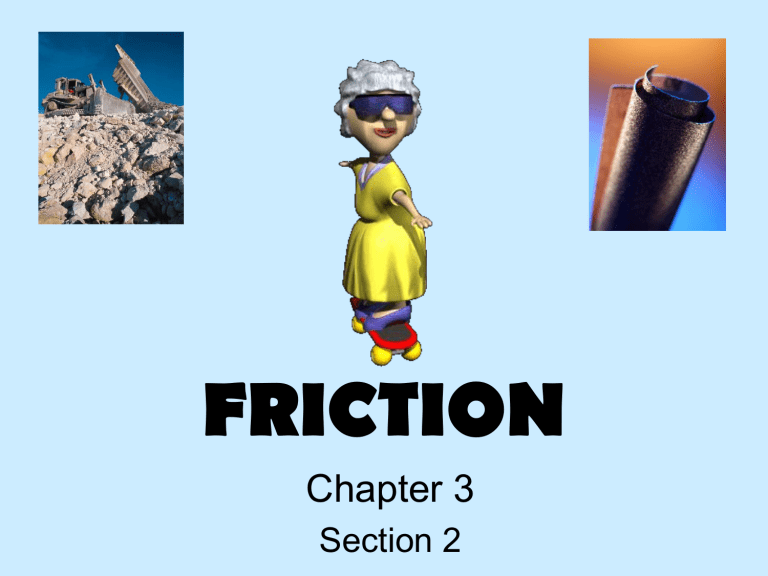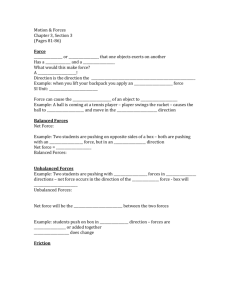Forces & Newton's Laws of Motion

FRICTION
Chapter 3
Section 2
Friction
• Suppose you decide to ride a skateboard.
• You push off the ground and start moving.
• According to Newton’s First Law of
Motion, if no other forces are acting on your skateboard, you will continue to move….BUT
• What happens?
• You slow down
Friction
• Your skateboard slows down because of friction.
• Friction is the force that opposes motion between two surfaces that are touching each other.
• The amount of two surfaces depends on two things:
– Kind of surface
– Forces pressing the surfaces together
What Causes Friction?
• Even though a surface may look smooth, if you magnify the surface it isn’t smooth.
• Everything is made of molecules. The molecules come together to make bumps. Some surfaces have molecules that leave large bumps and some leave smaller bumps, but all surfaces have bumps.
• Microwelds occur when two bumpy surfaces are rubbed up against each other they stick together .
Sticking Together
• The greater the force on the object, the greater the force of the microwelds and the greater force is needed to overcome the microwelds to move the object.
Static Friction
• Suppose your kid brother gets into a box and wants you to move him. He is too heavy to lift.
• You try to push the box and it doesn’t move.
• What type of acceleration does it have?
• Zero Acceleration
Static Friction
• Remember Newton’s Second Law of Motion
• If the acceleration is zero, the net force is zero.
• Therefore, because you can’t move it, another force is being applied to cancel out your force.
• That opposing force is friction caused by the microwelds between the bottom of the box and the floor.
• This type of friction is called static friction.
Static Friction
• Static Friction is the friction between two surfaces that are not moving past each other.
• In this case, your push is not large enough to break the microwelds and the box remains stuck to the floor.
Sliding Friction
• To help you move your kid brother, you decide to ask a friend.
• You both push and slowly, but not easily, the box starts to slide across the floor.
• When you stop pushing, it quickly stops moving.
• Sliding the box is difficult and there is still resistance.
• Although you have overcome the microwelds, there is still a sliding friction occurring.
Sliding Friction
• Sliding Friction is the force that opposes the motion of two surfaces sliding past each other.
• Sliding friction is caused by microwelds constantly breaking and then forming again as the box slides along the floor.
• To keep the box moving, you must continually apply a force to overcome sliding friction.
Rolling Friction
• Have you ever seen a car stuck in the snow.
Every time the driver steps on the gas, the tires just spin and the car doesn’t go anywhere?
• This is because there isn’t enough friction between the slippery ground and the tires.
• How could you create more friction to get the tires to move the car?
• Drop sand, gravel, put a board under each of the front tires.
Rolling Friction
• The friction between the rolling tires and the ground is called rolling friction.
• Rolling friction works partly because of microwelds.
• Rolling friction is much less friction than static or sliding friction.
• That is why it is easier to use a dolly than pushing your kid brother in the box.
Friction
• Why do some people add sand to their trunks during the winter months?
• How does this apply to any of
Newton’s Laws?




